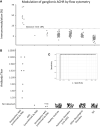A Flow Cytometric Assay to Detect Functional Ganglionic Acetylcholine Receptor Antibodies by Immunomodulation in Autoimmune Autonomic Ganglionopathy
- PMID: 34249013
- PMCID: PMC8261233
- DOI: 10.3389/fimmu.2021.705292
A Flow Cytometric Assay to Detect Functional Ganglionic Acetylcholine Receptor Antibodies by Immunomodulation in Autoimmune Autonomic Ganglionopathy
Abstract
Autoimmune Autonomic Ganglionopathy (AAG) is an uncommon immune-mediated neurological disease that results in failure of autonomic function and is associated with autoantibodies directed against the ganglionic acetylcholine receptor (gnACHR). The antibodies are routinely detected by immunoprecipitation assays, such as radioimmunoassays (RIA), although these assays do not detect all patients with AAG and may yield false positive results. Autoantibodies against the gnACHR exert pathology by receptor modulation. Flow cytometric analysis is able to determine if this has occurred, in contrast to the assays in current use that rely on immunoprecipitation. Here, we describe the first high-throughput, non-radioactive flow cytometric assay to determine autoantibody mediated gnACHR immunomodulation. Previously identified gnACHR antibody seronegative and seropositive sera samples (RIA confirmed) were blinded and obtained from the Oxford Neuroimmunology group along with samples collected locally from patients with or without AAG. All samples were assessed for the ability to cause gnACHR immunomodulation utilizing the prototypical gnACHR expressing cell line, IMR-32. Decision limits were calculated from healthy controls, and Receiver Operating Characteristic (ROC) curves were constructed after unblinding all samples. One hundred and ninety serum samples were analyzed; all 182 expected negative samples (from healthy controls, autonomic disorders not thought to be AAG, other neurological disorders without autonomic dysfunction and patients with Systemic Lupus Erythematosus) were negative for immunomodulation (<18%), as were the RIA negative AAG and unconfirmed AAG samples. All RIA positive samples displayed significant immunomodulation. There were no false positive or negative samples. There was perfect qualitative concordance as compared to RIA, with an Area Under ROC of 1. Detection of Immunomodulation by flow cytometry for the identification of gnACHR autoantibodies offers excellent concordance with the gnACHR antibody RIA, and overcomes many of the shortcomings of immunoprecipitation assays by directly measuring the pathological effects of these autoantibodies at the cellular level. Further work is needed to determine the correlation between the degree of immunomodulation and disease severity.
Keywords: autoimmune autonomic ganglionopathy; diagnostic test; flow cytometry—methods; immunoassay; neuroimmunology.
Copyright © 2021 Urriola, Spies, Blazek, Lang and Adelstein.
Conflict of interest statement
The authors declare that the research was conducted in the absence of any commercial or financial relationships that could be construed as a potential conflict of interest.
Figures




Similar articles
-
Evaluation of commercially available antibodies and fluorescent conotoxins for the detection of surface ganglionic acetylcholine receptor on the neuroblastoma cell line, IMR-32 by flow cytometry.J Immunol Methods. 2021 Nov;498:113124. doi: 10.1016/j.jim.2021.113124. Epub 2021 Aug 21. J Immunol Methods. 2021. PMID: 34425081
-
Autoimmune autonomic ganglionopathy: Ganglionic acetylcholine receptor autoantibodies.Autoimmun Rev. 2022 Feb;21(2):102988. doi: 10.1016/j.autrev.2021.102988. Epub 2021 Oct 30. Autoimmun Rev. 2022. PMID: 34728435 Review.
-
Subunit-specific autoantibodies in autoimmune autonomic ganglionopathy.J Neuroimmunol. 2022 Feb 15;363:577805. doi: 10.1016/j.jneuroim.2021.577805. Epub 2022 Jan 2. J Neuroimmunol. 2022. PMID: 34995917
-
A comprehensive analysis of the clinical characteristics and laboratory features in 179 patients with autoimmune autonomic ganglionopathy.J Autoimmun. 2020 Mar;108:102403. doi: 10.1016/j.jaut.2020.102403. Epub 2020 Jan 8. J Autoimmun. 2020. PMID: 31924415
-
[Autoimmune autonomic ganglionopathy].Rinsho Shinkeigaku. 2019 Dec 25;59(12):783-790. doi: 10.5692/clinicalneurol.cn-001354. Epub 2019 Nov 23. Rinsho Shinkeigaku. 2019. PMID: 31761837 Review. Japanese.
Cited by
-
Effectiveness of treatment for 31 patients with seropositive autoimmune autonomic ganglionopathy in Japan.Ther Adv Neurol Disord. 2022 Aug 3;15:17562864221110048. doi: 10.1177/17562864221110048. eCollection 2022. Ther Adv Neurol Disord. 2022. PMID: 35966941 Free PMC article.
-
The Presence of Ganglionic Acetylcholine Receptor Antibodies in Sera from Patients with Functional Gastrointestinal Disorders: A Preliminary Study.J Pers Med. 2024 Apr 30;14(5):485. doi: 10.3390/jpm14050485. J Pers Med. 2024. PMID: 38793066 Free PMC article.
-
Severe treatment-refractory antibody positive autoimmune autonomic ganglionopathy after mRNA COVID19 vaccination.Autoimmun Rev. 2022 Dec;21(12):103201. doi: 10.1016/j.autrev.2022.103201. Epub 2022 Sep 20. Autoimmun Rev. 2022. PMID: 36210629 Free PMC article.
-
Novel Cell-Based Assay for Alpha-3 Nicotinic Receptor Antibodies Detects Antibodies Exclusively in Autoimmune Autonomic Ganglionopathy.Neurol Neuroimmunol Neuroinflamm. 2022 Mar 29;9(3):e1162. doi: 10.1212/NXI.0000000000001162. Print 2022 May. Neurol Neuroimmunol Neuroinflamm. 2022. PMID: 35351814 Free PMC article.
-
Autoimmune Autonomic Neuropathy: From Pathogenesis to Diagnosis.Int J Mol Sci. 2024 Feb 15;25(4):2296. doi: 10.3390/ijms25042296. Int J Mol Sci. 2024. PMID: 38396973 Free PMC article. Review.
References
-
- Nakane S, Higuchi O, Koka M, Kanda T, Murata K, Suzuki T, et al. . Clinical Features of Autoimmune Autonomic Ganglionopathy and the Detection of Subunit-Specific Autoantibodies to the Ganglionic Acetylcholine Receptor in Japanese Patients. PloS One (2015) 10:e0118312. 10.1371/journal.pone.0118312 - DOI - PMC - PubMed
MeSH terms
Substances
LinkOut - more resources
Full Text Sources
Medical

